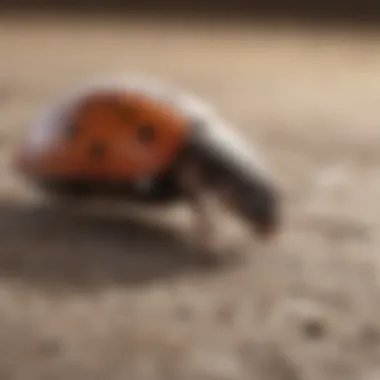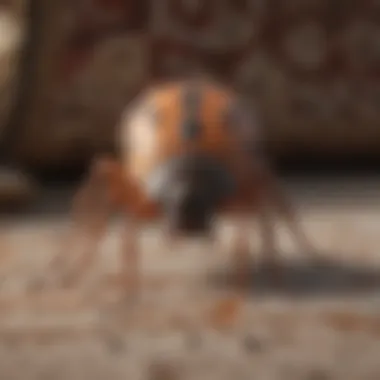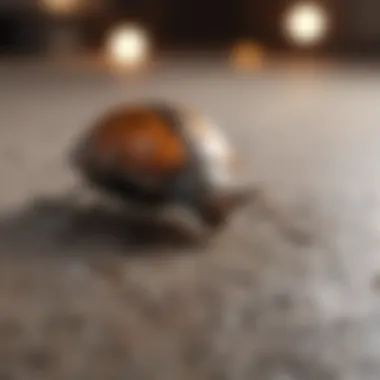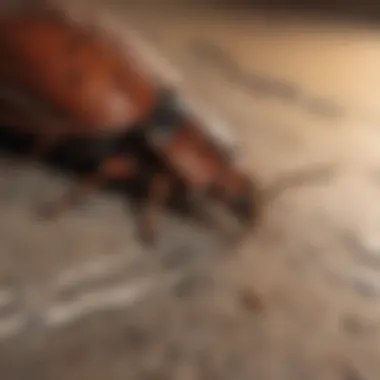Effective Ways to Eliminate Carpet Bugs: A Detailed Guide


Animal Species Profile
Carpet bugs, commonly known as carpet beetles or dermestids, belong to the order Coleoptera. These minuscule insects measure around 1 to 4 millimeters in length and have an elongated, oval-shaped body. Their coloration varies from black to a mottled pattern of white, yellow, and black scales. Carpet bugs are adept at blending into their surroundings, making them challenging to detect.
Physical Characteristics and Appearance
Carpet bugs have distinct physical characteristics that set them apart from other household pests. Their bodies are covered in specialized scales that form intricate patterns, providing them with camouflage against natural elements and predators. Due to their small size and ability to squeeze into tight spaces, carpet bugs can infiltrate homes through minuscule openings in walls, windows, or doors.
Natural Habitat and Distribution
Carpet bugs are cosmopolitan insects, meaning they can thrive in various environments globally. They are commonly found in households, feeding on organic materials such as wool, fur, feathers, and even dried food products. These adaptable pests seek out dark, secluded areas to lay their eggs and feed on suitable materials, making carpets, upholstery, clothing, and stored food vulnerable to infestation.
Behavior and Social Interactions
Despite their diminutive size, carpet bugs exhibit fascinating behavior patterns. They are nocturnal insects, preferring to remain active during the night when their prey is less vigilant. Carpet bugs possess a keen sense of smell, allowing them to locate suitable feeding sources efficiently. Additionally, these pests can reproduce rapidly, leading to significant infestations if left unchecked.
Understanding Carpet Bugs
In our comprehensive guide on how to eradicate carpet bugs from your living space, understanding the nature of these pests serves as a crucial foundation. By delving into the intricacies of carpet bugs, readers will equip themselves with the knowledge necessary to effectively identify and combat infestations. This section sheds light on the behavioral patterns and characteristics of carpet bugs, offering insights into their habitat preferences, feeding habits, and reproduction cycles. Understanding carpet bugs is paramount to devising a targeted pest control strategy, as it allows homeowners to tailor prevention and extermination methods to suit the specific vulnerabilities of these insidious insects.
What Are Carpet Bugs?
Exploring the realm of carpet bugs unveils a myriad of intriguing details about these small yet resilient creatures. Their ability to camouflage within carpet fibers and upholstery poses a challenge for detection, making it essential to grasp their distinctive characteristics. Here, we embark on a journey to unravel the essence of carpet bugs and their defining traits. Through a detailed examination of their physical appearance, behavior, and impact on household hygiene, readers will gain a profound understanding of why carpet bugs are a persistent nuisance. By illuminating the unique features that set carpet bugs apart from other household pests, this section underscores the significance of vigilance and proactiveness in preventing infestations.
Identifying Carpet Bug Infestations


To effectively combat carpet bugs, one must first be adept at recognizing the telltale signs of their presence within the home environment. This subsection focuses on elucidating the subtle clues that indicate a carpet bug infestation, ranging from visible damage to fabrics and carpets to the emergence of skin irritation among residents. By elucidating the behaviors and habits of carpet bugs that give rise to these indicators, readers will be empowered to swiftly address infestations before they escalate. By grasping the nuances of identifying carpet bug infestations, individuals can take proactive measures to safeguard their homes and possessions from the detrimental effects of these resilient pests.
Preventive Measures
Preventive measures play a vital role in combating carpet bugs infestations. By implementing proactive strategies, homeowners can effectively protect their carpets and fabrics from these pesky pests. Maintaining cleanliness is key to preventing carpet bug infestations. Regular vacuuming and decluttering are indispensable practices in this endeavor. Regular vacuuming helps in removing dust, dirt, and potential food sources that attract carpet bugs. Decluttering minimizes hiding spots for bugs, reducing the likelihood of infestations. These simple yet crucial tasks contribute significantly to creating an inhospitable environment for carpet bugs.
Maintaining Cleanliness
In the pursuit of a bug-free home, regular vacuuming and decluttering take precedence. Embracing a routine of consistent vacuuming helps eliminate dust and debris - common attractants for carpet bugs. Decluttering, on the other hand, reduces potential hiding spots for these pests. The combination of these practices ensures a clean and bug-resistant environment within homes. Their simplicity and efficiency make them go-to strategies for homeowners combatting carpet bug issues.
Regular vacuuming and decluttering tips
Regular vacuuming and decluttering form the cornerstone of a resilient defense against carpet bugs. Vacuuming carpets, rugs, and upholstery on a weekly basis removes debris, dust, and eggs that might be lurking within fibers. Focus on high-traffic areas and under furniture where bugs often hide. Decluttering involves tidying up spaces, minimizing piles of clothes or papers that serve as ideal hiding spots. This methodical approach not only enhances cleanliness but also acts as a preventive measure against potential infestations.
Sealing Cracks and Gaps
Properly sealing cracks and gaps in walls, floors, and around windows is essential in preventing carpet bugs from entering homes. By addressing these potential entry points, homeowners create barriers that deter bugs from infiltrating their living spaces. The effectiveness of this method lies in its ability to block off common pathways used by carpet bugs, significantly reducing the chances of infestations.
Methods to seal entry points for carpet bugs
Sealing cracks and gaps is a meticulous task that requires attention to detail. Using caulk to seal small openings and installing weather stripping for gaps around doors and windows are effective strategies. Inspecting and sealing gaps in flooring and walls also play a crucial role in bug prevention. These methods not only enhance the overall insulation of the home but also act as formidable defenses against carpet bugs.
Proper Storage Techniques
Adopting proper storage techniques is imperative in safeguarding clothes and fabrics from carpet bug infestations. Guidelines for storing items in sealed containers, vacuum-sealed bags, or using mothballs can help prevent bugs from accessing and damaging textiles. These proactive measures not only protect belongings but also minimize the risk of infestations, ensuring a bug-free storage environment.


Guidelines for storing clothes and fabrics to prevent infestations
Proper storage practices involve keeping clothes and fabrics in sealed containers or zip-lock bags to prevent bug access. Vacuum-sealed bags are particularly useful for bulky items like winter clothing or blankets. Additionally, using items like cedar blocks or mothballs can act as natural deterrents for carpet bugs. By adhering to these guidelines, homeowners can effectively safeguard their textiles and ward off potential infestations, ensuring the longevity of their clothing and fabrics.
Natural Remedies for Carpet Bugs
In the realm of pest control, the section on Natural Remedies for Carpet Bugs holds significant importance. Within the landscape of carpet bug management, the utilization of natural solutions becomes a crucial focal point. Not only do natural remedies offer a safer alternative compared to chemical treatments, but they also align with the ethos of eco-friendliness and sustainability. For conscientious homeowners looking to tackle carpet bug infestations without harsh chemicals, exploring natural remedies presents a compelling option. By delving into essential oils and diatomaceous earth, individuals can discover effective means to combat these resilient pests. The integration of natural remedies within this guide caters to those seeking environmentally conscious solutions while ensuring the effective eradication of carpet bugs.
Essential Oils
Amidst the diverse array of natural remedies for carpet bugs, essential oils stand out as a notable contender in pest management strategies. The particular focus on the Effectiveness of essential oils in repelling carpet bugs unveils a compelling facet of natural pest control. Embraced for their potent fragrances and inherent insect-repellent properties, essential oils serve as a formidable deterrent against carpet bugs. The essence of these oils acts as a barrier, deterring pests from inhabiting carpets and fabrics within homes. This natural approach not only safeguards living spaces from harmful chemicals but also imbues a pleasant aroma. However, it is essential to acknowledge the nuances in application and potency when leveraging essential oils for pest control, ensuring optimal efficacy and long-lasting protection.
Effectiveness of essential oils in repelling carpet bugs
Diving deeper into the realm of natural pest control, the Effectiveness of essential oils in repelling carpet bugs emerges as a pivotal aspect of this comprehensive guide. The key characteristic of essential oils lies in their ability to disrupt the pheromone trails of carpet bugs, preventing them from congregating and breeding within carpets and clothing. This disruption effectively disrupts the pests' communication and navigation, reducing their presence and inhibiting infestations. Homeowners opting for essential oils as a form of pest repellent benefit from a holistic approach that not only eradicates current infestations but also deters future ones. Despite their efficacy, it is essential to consider factors such as oil concentration, application frequency, and potential sensitivities, ensuring a balanced and effective use of essential oils within the context of carpet bug control.
Diatomaceous Earth
Within the realm of natural insecticides, Diatomaceous Earth emerges as a prominent player renowned for its efficacy in pest control. Embraced for its abrasive properties and natural composition, diatomaceous earth presents a formidable barrier against carpet bugs. The emphasis on Using diatomaceous earth as a natural insecticide underscores the significance of this mineral-based remedy in combating pest infestations. Leveraging the abrasive nature of diatomaceous earth, homeowners can create a protective layer that dehydrates and damages the exoskeleton of carpet bugs upon contact. This physical mechanism of action proves highly effective in eradicating pests while minimizing environmental impact. However, considerations regarding food-grade diatomaceous earth, application techniques, and safety precautions are paramount to maximize its efficacy and ensure a safe pest control approach.
Using diatomaceous earth as a natural insecticide
Exploring the practical applications of diatomaceous earth within pest management unveils a strategic yet natural approach to combating carpet bugs. The unique feature of diatomaceous earth lies in its mechanical action, which punctures the waxy layer of insects' exoskeleton, leading to desiccation and eventual demise. This methodical approach offers homeowners a non-toxic and chemical-free solution for addressing carpet bug infestations effectively. While the advantages of diatomaceous earth include its natural composition and rapid pest eradication, understanding its limitations, such as susceptibility to moisture and specific application protocols, is crucial for ensuring optimal outcomes within the context of this guide.
Chemical Treatments


The section on Chemical Treatments plays a pivotal role in this comprehensive guide on how to get rid of carpet bugs. Chemical treatments are a crucial aspect of pest control, offering effective solutions to eradicate stubborn infestations. By delving into the realm of chemical treatments, readers can explore a range of methods to combat carpet bugs with precision and efficacy. Understanding the implications of using chemicals and the impact on the environment is essential for responsible pest management.
Insecticides
Overview of chemical sprays for carpet bug control
In discussing the Overview of chemical sprays for carpet bug control, it becomes evident that these sprays are indispensable weapons in the battle against carpet bugs. Their fast-acting nature and ability to target specific areas make them a preferred choice for immediate relief from infestations. The key characteristic of chemical sprays lies in their potent formulation, designed to exterminate carpet bugs effectively. While these sprays offer quick results, it is crucial to follow safety guidelines for usage to prevent any harm to humans or pets. The unique feature of chemical sprays is their versatility, as they can be applied directly to infested areas, including carpets, rugs, and furniture. However, their strong chemicals may pose risks if not handled with care, underscoring the importance of mindful application in line with manufacturer recommendations.
Professional Extermination
When to seek help from pest control experts
Knowing when to seek help from pest control experts is a critical decision in addressing severe carpet bug infestations. Pest control professionals bring expertise and specialized tools to effectively eliminate carpet bugs from your home. Their specialized knowledge allows for a targeted approach, identifying the root causes of infestations and implementing tailored solutions. Seeking professional extermination services is beneficial when home remedies and over-the-counter solutions prove ineffective. The unique feature of professional extermination lies in the comprehensive treatment plans offered, which include inspection, treatment, and follow-up to ensure long-term eradication of carpet bugs. While professional assistance may come at a cost, the advantages of guaranteed results and peace of mind justify the investment in safeguarding your home from persistent pest threats.
Post-Treatment Steps
Post-treatment steps are crucial in ensuring the efficacy of the carpet bug elimination process. After implementing treatment measures, maintaining vigilance is key to preventing reinfestations. These steps act as a safeguard against any resurgence of carpet bugs in your home. Due to the resilience of these pests, post-treatment care is essential to secure a bug-free environment. Regularly monitoring and following up after initial treatment can significantly reduce the chances of a reinfestation.
Monitoring for Reinfestations
Monitoring for reinfestations is a critical part of the post-treatment regimen. By examining key areas where carpet bugs tend to thrive, you can detect any signs of a resurgence early on. Implementing thorough monitoring techniques will allow you to spot any potential issues promptly, enabling quick intervention to prevent a full-blown infestation. Regularly check hidden corners, carpets, and furniture for any traces of carpet bugs to stay ahead of any possible reinfestation.
Tips for ensuring the effectiveness of treatment
One crucial aspect of monitoring for reinfestations is the thoroughness of inspection. Ensure that every nook and cranny is meticulously examined for any signs of carpet bugs. Consistent and detailed monitoring can help identify any resurgence at the earliest stage. By setting up a systematic monitoring schedule post-treatment, you can effectively track and address any pest activity. This proactive approach enhances the overall effectiveness of the treatment, maintaining a bug-free environment in the long run.
Maintaining Vigilance
Maintaining vigilance against carpet bugs is a continuous effort that requires long-term strategies for prevention. By implementing consistent practices to deter these pests, you can safeguard your home from future infestations. Vigilance is essential to prevent any potential reinfestation and maintain a pest-free environment. Adopting sustainable habits and preventive measures is key to ensuring a bug-free living space.
Long-term strategies to prevent future carpet bug issues
One effective strategy for preventing future carpet bug problems is to address any potential entry points in your home. Seal cracks, gaps, and openings that may serve as access points for these pests. Additionally, practicing good hygiene by regularly cleaning and decluttering your living spaces can create an inhospitable environment for carpet bugs. By incorporating these long-term strategies into your routine, you can significantly reduce the risk of future infestations and enjoy a bug-free home environment.







